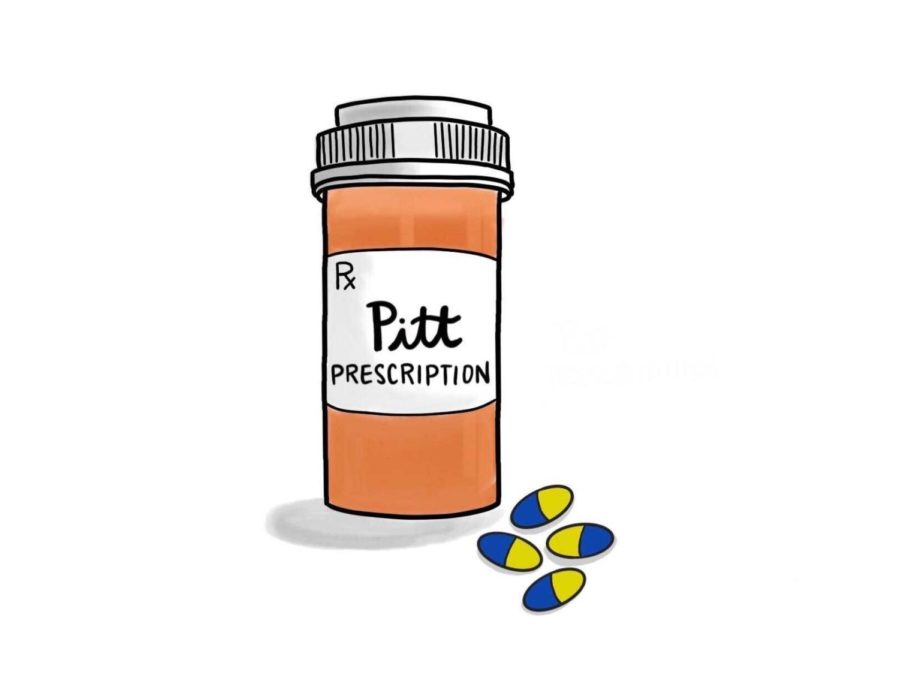The Pitt Prescription | Self-care for pesky cold and canker sores
The Pitt Prescription is a biweekly blog where student pharmacist and senior staff writer Elizabeth Donnelly provides tips on how to stay healthy in college. This edition was reviewed by Karen Pater, PharmD, CDCES, BCACP.
Shruti Talekar | Contributing Editor
The Pitt Prescription
October 21, 2021
If you’ve ever had a cold or canker sore, you know that they can be difficult to manage once they’ve fully formed. There are several self-care measures that may be taken to prevent or treat these pesky sores.
What are the differences between cold and canker sores?
Cold sores, otherwise known as “fever blisters,” are a symptom of a viral infection caused by the herpes simplex virus (HSV-1). There are different strains of this virus, such as the one that causes the sexually transmitted infection of genital herpes (HSV-2), which is why this condition is sometimes called “oral herpes.”
Cold sores are small blisters located on or around your lips and mouth. They are often grouped together and heal in around two to three weeks. These sores are very contagious, even if sores are not visible, and most often spread by person-to-person contact like kissing or oral sex. Something important to note is that someone with an active cold sore infection can spread the virus to another individual’s genitals, resulting in genital herpes. So even though cold sores are not typically considered a STI, they can be spread to the genital region and can cause sores to this area of the body.
Cold sores usually go through different stages as they form. Initially, people may feel a tingling sensation with some burning or itching for a day before blisters begin to appear. Once blisters arrive, they usually appear around the edge of the mouth and, finally, the blisters may join together then burst, leaving open sores that crust over. Once someone has had a cold sore, the virus remains in their body forever, staying dormant until a recurrent infection occurs.
Canker sores, also known as “aphthous ulcers,” are much simpler than cold sores. They are small and shallow lesions that occur inside of the mouth rather than outside around the lips. Also, these sores are not contagious so they can’t be spread from person to person. Canker sores are not caused by viral infection like cold sores — instead their exact cause remains unclear. Several factors may contribute to the formation of a canker sore, such as minor mouth injuries (like an accidental cheek bite or mouth injury from braces), food sensitivities, hormonal shifts, stress and more.
Canker sores initially present with a tingling or burning feeling inside the mouth a couple days before the sores actually form, similar to cold sores. There are a few different types of sores, but the most common are minor canker sores, which are typically small and oval shaped with red edges.
Self-care remedies and prevention for cold and canker sores
Luckily, both cold and canker sores go away by themselves after a couple of weeks. There is no “cure” for either of these sores, but there are treatment options to help alleviate symptoms and speed up the healing process.
According to the American Pharmacists Association’s “Handbook of Nonprescription Drugs,” the goals of treatment for cold sores are to relieve pain and irritation, promote sore healing and prevent any future complications, such as infection, from arising. Also, we want to prevent transmission of the sores from person to person. For canker sores, the goals are identical except for preventing transmission, since they are not contagious. The handbook also lists several treatment options for both cold and canker sores that individuals can do at home.
Pharmacological treatment of cold sores consists of the cold sore-specific medication docosanol (Abreva), ointment and pain relievers.
- Docosanol is FDA-approved for treatment of HSV-1 cold sores, the most common herpes simplex virus to cause these sores. It is recommended to apply at the first signs of a cold sore breakout, usually when you feel the tingling or burning sensation. You can apply it up to five times daily but should not be used for more than 10 days in a row. If used immediately at the onset of cold sore formation, it significantly reduces the median time of healing and reduces the duration of symptoms.
- White petrolatum products like Vaseline can help keep cold sores moist and prevent drying or cracking. It is recommended to apply a thin layer to the sore and surrounding affected area as needed.
- You can take pain relievers like acetaminophen (Tylenol) and ibuprofen (Motrin, Advil) to alleviate some of the pain associated with cold sores. People typically use ibuprofen for oral pain due to its anti-inflammatory effects. A typical recommended dose of ibuprofen is taking two 200-milligram tablets every six hours, not exceeding 1200 mg (six tablets) total daily. A typical recommended dose of acetaminophen is taking two 500-mg tablets every six hours, not exceeding 3000 mg (six tablets) total daily.
Pharmacological treatment of canker sores consists of oral wound cleansing agents, topical oral anesthetics, topical oral protectants and pain relievers.
- Wound cleansing agents using carbamide peroxide 10% (like Gly-Oxide Oral Cleanser) or hydrogen peroxide 1.5% (like Orajel Antiseptic Mouth Sore Rinse) help to remove debris from open sores and clean any wounds. The recommended use of these products is to place a few drops on the affected area for one minute and then rinse your mouth out. They can be used up to four times daily, but should not be used for more than seven days in a row.
- Topical oral anesthetics include benzocaine (like Orajel Mouth Sore Gel) or menthol and camphor (like Carmex Lip Balm) may temporarily help alleviate pain when applied to the affected areas. You should apply an oral anesthetic up to four times daily, but should not be used for more than seven days in a row.
- Topical oral protectants using menthol (like Canker Cover) coat the sores to help protect from friction and provide some symptomatic relief. You should apply these covers to the sore and hold for 10-20 seconds for application. The cover can last for several hours but may require re-application up to three times daily.
- The pain relievers people can use for canker sores are the same as for cold sores detailed above.
Non-pharmacological therapies for cold and canker sores involve avoiding spicy or irritating foods, using ice on the sores in 10-minute increments and gargling with a salt water mixture (1 teaspoon of salt in a cup of lukewarm water) for 60 seconds.
With cold sores, preventative measures are also important. Avoid kissing others or initiating skin to skin contact while blisters are present. Additionally, avoid sharing food and drinks and make sure to wash your hands well. Cold and canker sores can be very bothersome, but these treatment and prevention techniques should be able to help provide some relief.
Elizabeth writes primarily about self-care and pharmacological topics. For questions, comments or concerns, you can reach her at ead85@pitt.edu.



